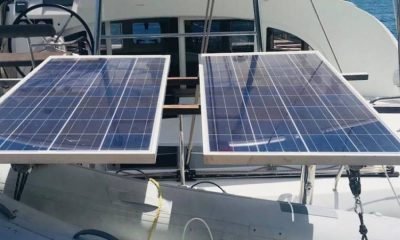Solar Technologies
Orange leads solar panel deployment across Africa and the Middle East

Paris, France, May 10, 2021/ Orange is accelerating its solar projects in Africa and the Middle East to reduce its carbon footprint to zero by 2040. Across the entire region, many sites are not connected to the electricity grid and when they are, the quality of the grid often requires alternative backup solutions. To avoid using generators that run on fuel (fossil energy that emits CO2), Orange is putting in place several initiatives such as solar panels.
To avoid using generators that run on fuel (fossil energy that emits CO2), Orange is putting in place several initiatives such as solar panels
In several of its subsidiaries, Orange is deploying innovative solar solutions and the latest generation batteries with partners specializing in energy. To reduce its environmental footprint, the Group is positioning itself in these countries as the biggest deployer of solar panels, with a renewable energy use rate already at over 50% for Orange Guinea, 41% for Orange Madagascar and 40% for Orange Sierra Leone.
These solar panel solutions have also been or will soon be deployed in other African and Middle Eastern countries where Orange is present, like Liberia, for instance, where 75% of Orange’s telecom sites are equipped with solar panels. In total, Orange has installed solar panels at 5,400 of its telecom sites (some 100% solar, others hybrid) saving 55 million liters of fuel each year.
Furthermore, in Jordan, Orange has launched three solar farms to switch to clean and renewable energy helping to reduce its carbon footprint. In 2020, these solar farm projects covered over 65% of Orange Jordan’s energy needs. Since 2018, the company has successfully reduced its CO2 emissions by 45 kilotons thanks to this solar infrastructure.
Alioune Ndiaye, CEO of Orange Middle East and Africa says:
“We are proud to be the first company by number of solar panels in 5 countries in Africa and the Middle East. As a stakeholder in the energy transition, Orange has included in its Engage 2025 strategic plan the objective of meeting 50% of the Group’s electricity needs from renewable sources by 2025. We are aiming for net zero carbon by 2040.”
Orange is present in 18 countries in Africa and the Middle East and has around 130 million customers as at March 31, 2021. With €5.8 billion in turnover in 2020, Orange MEA is the Group’s main growth region. Orange Money, with its mobile-based money transfer and financial services offer is available in 17 countries and has 50 million customers. Orange, a multi-service operator, benchmark partner of the digital transformation, provides its expertise to support the development of new digital services in Africa and the Middle East.
Solar Technologies
A Positive Charge for Energy Storage

The transition to clean energy is underway. The adoption of microgrids and hybrid power systems gains momentum seemingly every day. This transformation is both inspired by and responsible for significant growth within the energy storage market, in addition to a surge of technological innovation.
Batteries are supportive technologies that can enhance the functionality, value, economics, and resiliency of renewable energy-based systems. They are becoming an integral component of the clean energy transition. Projected growth worldwide is significant, in the next 10 years, energy storage capacity is expected to reach a 33% compound annual growth rate (CAGR) and a cumulative capacity of 741 gigawatt-hours by 2030.
Analysts predict that in the coming years, as countries around the world work to recover from the pandemic, rebuild their economies, and reinforce their infrastructure while moving forward with the transition to clean energy, many will look to energy storage as a technology solution. In fact, close to 10,000 gigawatt-hours of energy storage will be needed worldwide by 2040 for the world to meet climate and sustainable energy goals, explains the IEA’s Sustainable Development Scenario. That’s 50 times the size of the current market.
Experts agree that accelerated innovation will be essential to achieve this growth. In tandem, safety experts are developing the certifications needed to provide guidance on the safe use of batteries.
US Energy Storage Forecast
In the US, utility resource planning is positioned to drive deployments in the coming decade. Utility approaches to renewables and energy storage have shifted in the past two years, as detailed in WoodMackenzie’s latest Energy Storage Monitor report, which indicates a majority of US utilities are embracing renewables and storage due to favorable costs and state-level clean energy policies. As a result, the report shows that the US storage market is set to surge through 2021.
Lithium-ion Technology Led the Way
Lithium-based batteries remain the leading energy storage technology for a variety of reasons, according to a recent Research and Markets report Li-ion Battery – Global Market Trajectory and Analytics. They have a clear advantage when weight is important, such as in vehicles and hand-held applications, due to their high energy density. Other desirable attributes include a low rate of self-discharge, low required maintenance, fast-charging capabilities, and longer life and durability.
However, experts agree that lithium-ion is not the only promising technology in the future of energy storage. In fact, many companies are currently focused on developing new, novel battery technologies that may be a better technical fit for stationary applications in the electric power industry where weight is not a critical factor.
Energy Storage Innovation on the Rise
Advances in energy storage technologies are set to catalyze the transition to clean energy around the world. And judging by the patent activity, battery innovation is gaining momentum. Between 2005 and 2018, patent filing in batteries and other electricity storage technologies grew at an average annual rate of 14% worldwide, four times faster than the average of all technology fields. According to the recent report, Innovation in batteries and electricity storage – a global analysis based on patent data, batteries now account for nearly 90% of all patenting activity in the area of electricity storage and that the rise in innovation is primarily driven by advances in rechargeable lithium-ion batteries used in consumer electronic devices and electric cars.
A noticeable trend among emerging battery technologies is a shift away from technologies reliant on rare earth minerals like nickel and cobalt. Cobalt is the least abundant and most expensive component in battery cathodes according to battery experts. Several companies have developed cobalt-free batteries that boast improved energy density, battery life, and safety. Novel energy storage technologies like zinc-air and aluminum-air rely on elements such as oxygen, sodium, and carbon, while other novel approaches capitalize on the properties of graphene, silica sand, and seawater.
Researchers from Harvard University and Stanford University have made significant strides to advance the development of liquid flow batteries. Current literature indicates that there is also a wave of innovation taking place in battery components. From hybrid anodes to nanowires made from gold and vertical carbon nanotube electrodes, these component upgrades aim to boost battery power and improve lifetime cycling.
Source: Laura Sanchez, https://microgridnews.com
Solar Technologies
Renewable power is defying the Covid crisis with record growth this year and next

Renewable power is growing robustly around the world this year, contrasting with the sharp declines triggered by the Covid-19 crisis in many other parts of the energy sector such as oil, gas and coal, according to a report from the International Energy Agency released today.
Driven by China and the United States, new additions of renewable power capacity worldwide will increase to a record level of almost 200 gigawatts this year, the IEA’s Renewables 2020 report forecasts. This rise – representing almost 90% of the total expansion in overall power capacity globally – is led by wind, hydropower and solar PV. Wind and solar additions are set to jump by 30% in both the United States and China as developers rush to take advantage of expiring incentives.
Even stronger growth is to come. India and the European Union will be the driving forces behind a record expansion of global renewable capacity additions of nearly 10% next year – the fastest growth since 2015 – according to the report. This is the result of the commissioning of delayed projects where construction and supply chains were disrupted by the pandemic, and growth in markets where the pre-Covid project pipeline was robust. India is expected to be the largest contributor to the renewables upswing in 2021, with the country’s annual additions doubling from 2020.
“Renewable power is defying the difficulties caused by the pandemic, showing robust growth while other fuels struggle,” said Dr Fatih Birol, the IEA Executive Director. “The resilience and positive prospects of the sector are clearly reflected by continued strong appetite from investors – and the future looks even brighter with new capacity additions on course to set fresh records this year and next.”
Over the first 10 months of 2020, China, India and the European Union have driven auctioned renewable power capacity worldwide 15% higher than in the same period last year – a new record that shows expectations of strong demand for renewables over the medium and long term. At the same time, shares of publicly listed renewable equipment manufacturers and project developers have been outperforming most major stock market indices and the overall energy sector. By October, shares of solar companies worldwide had more than doubled in value from December 2019.
However, policy makers still need to take steps to support the strong momentum behind renewables. In the IEA report’s main forecast, the expiry of incentives in key markets and the resulting uncertainties lead to a small decline in renewables capacity additions in 2022. But if countries address these policy uncertainties in time, the report estimates that global solar PV and wind additions could each increase by a further 25% in 2022.
Critical factors influencing the pace of deployment will be policy decisions in key markets like China, and effective support for rooftop solar PV, which has been impacted by the crisis as households and businesses reprioritised investments. Under favourable policy conditions, solar PV annual additions could reach a record level of 150 gigawatts (GW) by 2022 – an increase of almost 40% in just three years.
“Renewables are resilient to the Covid crisis but not to policy uncertainties,” said Dr Birol. “Governments can tackle these issues to help bring about a sustainable recovery and accelerate clean energy transitions. In the United States, for instance, if the proposed clean electricity policies of the next US administration are implemented, they could lead to a much more rapid deployment of solar PV and wind, contributing to a faster decarbonisation of the power sector.”
The electricity generated by renewable technologies will increase by 7% globally in 2020, underpinned by the record new capacity additions, the report estimates. This growth comes despite a 5% annual drop in global energy demand, the largest since the Second World War.
However, renewables outside the electricity sector are suffering from the impacts of the Covid crisis. Biofuels used in transport are set to experience their first annual decline in two decades, driven by the wider plunge in transport fuel demand this year as well as lower fossil fuel prices reducing the economic attractiveness of biofuels. Demand for bioenergy in industry is also falling as a result of the wider drop in economic activity. The net result of these declines and the growth of renewable power is an expected overall increase of 1% in global renewable energy demand in 2020.
Renewable fuels for transport and industry are an area in particular need of potential policy support, as the sector has been severely hit by the demand shock caused by the crisis. More can and should be done, to support deployment and innovation in bioenergy to supply sustainable fuels for those sectors.
The report’s outlook for the next five years sees cost reductions and sustained policy support continuing to drive strong growth in renewable power technologies. Total wind and solar PV capacity is on course to surpass natural gas in 2023 and coal in 2024. Driven by rapid cost declines, annual offshore wind additions are set to surge, accounting for one-fifth of the total wind market in 2025. The growing capacity will take the amount of renewable electricity produced globally to new heights.
“In 2025, renewables are set to become the largest source of electricity generation worldwide, ending coal’s five decades as the top power provider,” said Dr Birol. “By that time, renewables are expected to supply one-third of the world’s electricity – and their total capacity will be twice the size of the entire power capacity of China today.”
Solar Technologies
Tripling renewables investment to reach climate goal

New report confirms global investment rise in 2013-2018, but calls for considerable mobilisation of capital to recover from COVID-19 and build a climate-safe world.
Global renewable energy investment increased between 2013 and 2018, reaching its peak at USD 351 billion in 2017, according to a new report by the International Renewable Energy Agency (IRENA) and Climate Policy Initiative (CPI).” The 2020 edition of Global Landscape of Renewable Energy Finance highlights however, that while a cumulative USD 1.8 trillion were invested during the five-year period, the amount falls short to achieve the global climate commitments.
Renewable energy investment slightly declined in 2018, with modest growth through 2019. Although this was largely due to the decreasing costs of renewables, the total installed capacity continued to grow. The current level of investment is still insufficient however to keep the rise in global temperatures within the 1.5°C objective by mid-century. To achieve this climate goal, investment in diverse renewables technologies must almost triple annually to USD 800 billion by 2050.
Ambitious commitments from governments are needed, backed by supporting measures such as moving subsidies away from fossil fuels. Further investments are also needed in system integration and enabling technologies that increase system flexibility such as batteries and energy storage. To that end, policies that enable the integration of new renewables capacity additions into the energy systems are needed, leading to their decarbonisation and bringing wide socio-economic benefits.
“The investment trend in renewable energy before COVID-19 was a positive one,” said Francesco La Camera, IRENA’s Director-General. “But COVID-19 has shown us that much more effort is urgently needed to put us on a climate compatible pathway and help us recover better with a sustainable, resilient economy. Decision makers must design systemic approaches to policies that encourage and speed up the flow of investment into renewables, and away from fossil fuels, and doing so enable economic growth, social resilience and welfare.”
IRENA’s post-COVID agenda showed that average annual investments of USD 2 trillion in renewables and other energy transition-related technologies in the 2021-2023-recovery phase could create 5.5 million additional jobs in the sector. An additional 19 million energy transition-related jobs would be created by 2030, following average annual investments of USD 4.5 trillion up to 2030.
The majority of these investments could come from private sources, if government funds are used strategically to nudge investment decisions and financing in the right direction. The capital is available, with a push from the governments to mobilise it. Public funds are able to leverage private investments by a factor of 3 to 4 if used strategically to steer investments toward clean energy solutions and away from fossil fuels. Greater participation of institutional investors – which hold about USD 87 trillion in assets – will help to reach the scale of global investment needed. To this end, it is key to promote the use of capital market solutions, such as green bonds, that address the needs of these investors. The potential role of institutional investors for the global energy transition is further explored in IRENA’s report, Mobilising Institutional Capital for Renewable Energy, published this month.
“There is a very clear need for a rapid increase of investment in renewable energy coupled with a significant reduction and redirection of investment away from fossil fuel energy,” said Dr Barbara Buchner, CPI’s Global Managing Director. “We call for more effort and coordination among policy makers, public and private finance institutions, energy and non-energy producing corporations, and institutional investors to speed up the global energy transition. This action is fundamental to a more sustainable and resilient future.“
This year’s joint report analyses for the first time financial commitments to off-grid renewables technologies in developing markets, as they can bring the world closer to achieving Sustainable Development Goal 7 on universal access to affordable, reliable, sustainable and modern energy by 2030. Providing cost-effective energy solutions, off-grid renewables are essential in a time when energy access is crucial to power healthcare facilities, save lives and create jobs. While investments in off-grid renewables solutions kept growing, reaching an all-time-high USD 460 million in 2019, additional capital must be unlocked especially for income-generating activities and productive uses to improve the livelihoods and resilience of billions of women and men globally and to promote socio-economic benefits.
Looking ahead, policy makers need to signal long-term political commitment and enhance partnerships with the private sector to boost investors confidence and attract additional private capital in the sector. To that effect, the report laid out five specific recommendations that policy makers should implement to engage private sector actors, including institutional investors, capital market players and non-energy producing companies, in the collective path to green recovery and climate objectives.
-

 Solar Panels7 years ago
Solar Panels7 years agoAre Tesla solar roof tiles worth it?
-

 Genel7 years ago
Genel7 years agoMaldives luxury resort is powered entirely by solar panels
-

 Control Systems Et Software7 years ago
Control Systems Et Software7 years agoHOMER responds to the rapidly growing solar+storage market with Grid software
-

 Solar Technologies6 years ago
Solar Technologies6 years agoGOODWE PARTNERSHIP WITH GE
-

 Solar Technologies5 years ago
Solar Technologies5 years agoSolar panel covered Autobahn can break speed record for Germany’s energy transition
-

 Operation and Maintenance7 years ago
Operation and Maintenance7 years ago1000-Acre Sunflower Solar Farm to be Built for Entergy Mississippi
-

 Events6 years ago
Events6 years agoGREENoneTEC revolutionizes solar heating with Sunpad
-

 Large -Scale Solar Panels7 years ago
Large -Scale Solar Panels7 years agoABB to construct solar power expansion in Dubai












